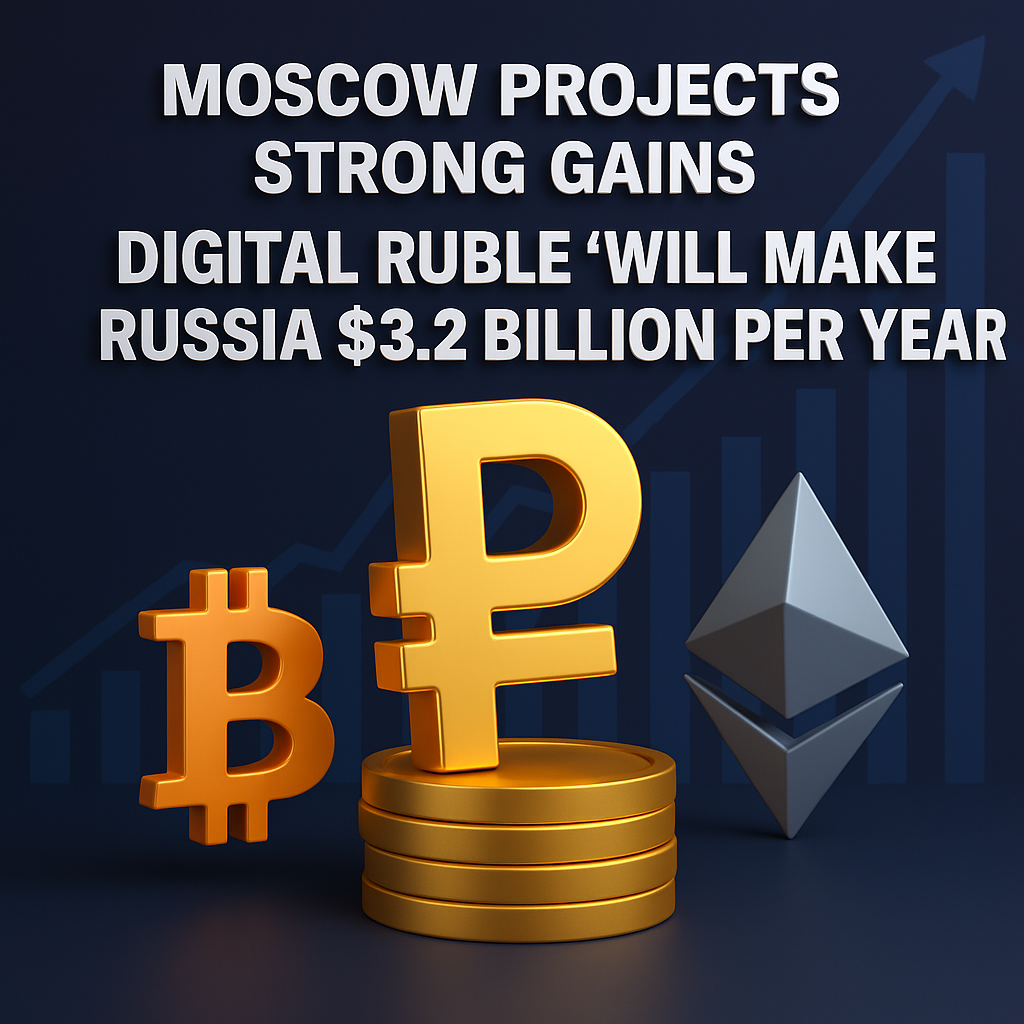Russia is moving closer to rolling out its central bank digital currency (CBDC)—the digital ruble—a project officials describe as a strategic leap in finance. According to the National Rating Agency (NRA), the Digital Ruble ‘Will Make Russia $3.2 Billion Per Year,’ Moscow Claims, making it one of the most ambitious projections linked to digital finance.
Unlike decentralized crypto currencies such as Bitcoin or Ethereum, which operate without government control, the digital ruble will be fully managed by the Central Bank of Russia. Supporters believe it will modernize the economy and strengthen sovereignty, while critics fear it may reduce financial freedom.
The $3.2 Billion Promise
By 2031, the NRA projects that the digital ruble could deliver up to ₽260 billion annually (around US $3.2 billion). These expected gains come from:
- Lower transaction fees for individuals and businesses.
- Faster, transparent settlements across the economy.
- New financial services powered by CBDC-backed infrastructure.
Officials claim the digital ruble could provide the efficiency often associated with cryptocurrencies but with the “stability” of state control. However, critics note that the trade-off may come at the cost of privacy—something Bitcoin and other cryptos emphasize.
Timeline of Rollout
The launch will follow a phased approach:
- 2026 – Initial rollout with large banks and major corporations.
- 2027–2028 – Integration for small and medium-sized businesses.
- By 2030 – Nationwide adoption across consumer payments.
This strategy aims to ensure gradual adaptation while balancing innovation with risk management.
Banks: Short-Term Disruption, Long-Term Gains
Banks are expected to feel immediate pressure, with projected losses of ₽45–95 billion annually as clients migrate from traditional services to CBDC wallets.
Yet by 2029–2031, Moscow predicts banks will recover through new CBDC-based products like digital wallets, smart-contract payment solutions, and blockchain-style services. These could generate ₽40–50 billion annually, mirroring the opportunities already seen in the cryptocurrency sector’s DeFi (Decentralized Finance) markets.
Businesses and Consumers: Who Gains Most?
Large corporations could save or earn ₽30–50 billion annually thanks to lower costs and faster transactions. Retailers and service providers may also benefit from reduced reliance on intermediaries.
For consumers, the digital ruble promises:
- Lower costs compared to bank transfers.
- Faster digital payments, similar to crypto transactions.
- Central bank guarantee for added security.
Still, adoption is uncertain. Surveys show 51% of Russians are reluctant to use the digital ruble, and 40% see no clear advantages. Privacy fears and government oversight remain the biggest hurdles—issues where cryptocurrencies still hold an edge.
Long-Term Outlook: By 2031 and Beyond
Despite skepticism, Moscow insists the Digital Ruble ‘Will Make Russia $3.2 Billion Per Year.’ By 2031, annual net benefits of ₽200–260 billion could reshape Russia’s financial system.
The government hopes the CBDC will:
- Strengthen financial independence in a sanction-heavy environment.
- Improve efficiency and transparency.
- Compete with global CBDC projects while offering a state-backed alternative to cryptocurrencies.
Yet, while the digital ruble may rival crypto in speed and accessibility, it cannot replicate the decentralization, anonymity, and global borderlessness of assets like Bitcoin. Instead, it represents a different model: a controlled, government-driven digital finance system.
Quick Snapshot
| Area | Forecasted Impact |
|---|---|
| Economic Boost | $3.2 billion annually (~₽260 billion) by 2031 |
| Corporate Profits | ₽30–50 billion yearly in early adoption |
| Banking Sector | Losses of ₽45–95 billion initially; long-term gains of ₽40–50 billion |
| Consumer Adoption | 51% reluctant; 40% see no benefits |
| Crypto Comparison | CBDC = centralized control; Crypto = decentralized freedom |
Conclusion
The Digital Ruble ‘Will Make Russia $3.2 Billion Per Year,’ Moscow Claims highlights the country’s ambition to lead in digital finance. If projections are met, it could become a powerful tool for economic growth and sovereignty.
However, the broader debate remains: CBDC vs. cryptocurrency. While Bitcoin and Ethereum continue to attract users seeking decentralization and privacy, the digital ruble offers stability under state control. Its success will depend on Russia’s ability to balance efficiency with trust—and whether citizens are willing to embrace a future where financial power sits firmly in government hands.



